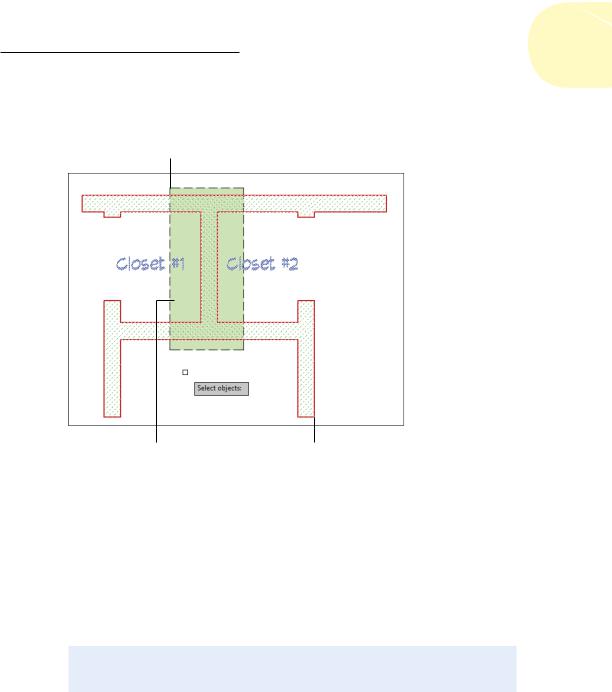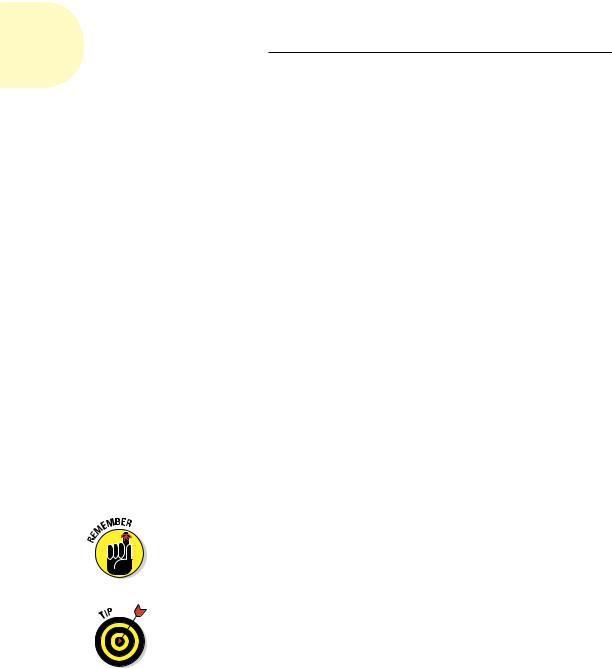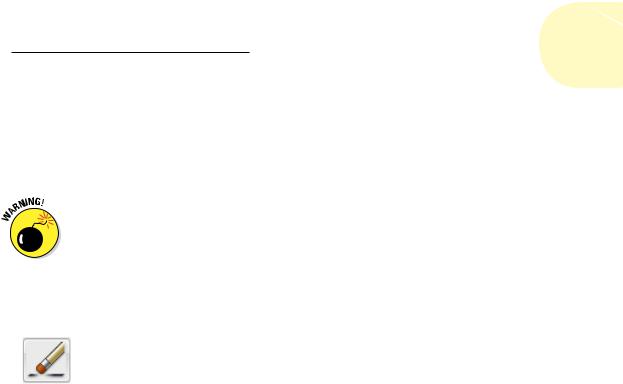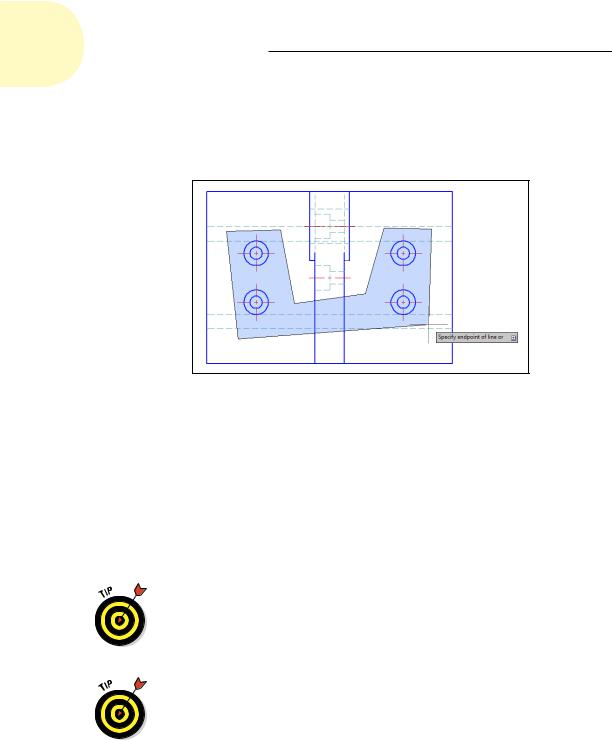
- •About the Authors
- •Dedication
- •Authors’ Acknowledgments
- •Table of Contents
- •Introduction
- •What’s Not (And What Is) in This Book
- •Mac attack!
- •Who Do We Think You Are?
- •How This Book Is Organized
- •Part I: AutoCAD 101
- •Part II: Let There Be Lines
- •Part III: If Drawings Could Talk
- •Part IV: Advancing with AutoCAD
- •Part V: On a 3D Spree
- •Part VI: The Part of Tens
- •But wait . . . there’s more!
- •Icons Used in This Book
- •A Few Conventions — Just in Case
- •Commanding from the keyboard
- •Tying things up with the Ribbon
- •Where to Go from Here
- •Why AutoCAD?
- •The Importance of Being DWG
- •Seeing the LT
- •Checking System Requirements
- •Suddenly, It’s 2013!
- •AutoCAD Does Windows (And Office)
- •And They’re Off: AutoCAD’s Opening Screens
- •Running with Ribbons
- •Getting with the Program
- •Looking for Mr. Status Bar
- •Let your fingers do the talking: The command window
- •The key(board) to AutoCAD success
- •Keeping tabs on palettes
- •Down the main stretch: The drawing area
- •Fun with F1
- •A Simple Setup
- •Drawing a (Base) Plate
- •Drawing rectangles on the right layers
- •Circling your plate
- •Nuts to you
- •Getting a Closer Look with Zoom and Pan
- •Modifying to Make It Merrier
- •Hip-hip-array!
- •Stretching out
- •Crossing your hatches
- •Following the Plot
- •A Setup Roadmap
- •Choosing your units
- •Weighing up your scales
- •Thinking annotatively
- •Thinking about paper
- •Defending your border
- •A Template for Success
- •Making the Most of Model Space
- •Setting your units
- •Making the drawing area snap-py (and grid-dy)
- •Setting linetype and dimension scales
- •Entering drawing properties
- •Making Templates Your Own
- •Setting Up a Layout in Paper Space
- •Will that be tabs or buttons?
- •View layouts Quick(View)ly
- •Creating a layout
- •Copying and changing layouts
- •Lost in paper space
- •Spaced out
- •A view(port) for drawing in
- •About Paper Space Layouts and Plotting
- •Managing Your Properties
- •Layer one on me!
- •Accumulating properties
- •Creating new layers
- •Manipulating layers
- •Using Named Objects
- •Using AutoCAD DesignCenter
- •Copying layers between drawings
- •Controlling Your Precision
- •Keyboard capers: Coordinate input
- •Understanding AutoCAD’s coordinate systems
- •Grab an object and make it snappy
- •Other Practical Precision Procedures
- •Introducing the AutoCAD Drawing Commands
- •The Straight and Narrow: Lines, Polylines, and Polygons
- •Toeing the line
- •Connecting the lines with polyline
- •Squaring off with rectangles
- •Choosing your sides with polygon
- •(Throwing) Curves
- •Going full circle
- •Arc-y-ology
- •Solar ellipses
- •Splines: The sketchy, sinuous curves
- •Donuts: The circles with a difference
- •Revision clouds on the horizon
- •Scoring Points
- •Commanding and Selecting
- •Command-first editing
- •Selection-first editing
- •Direct object manipulation
- •Choosing an editing style
- •Grab It
- •One-by-one selection
- •Selection boxes left and right
- •Perfecting Selecting
- •AutoCAD Groupies
- •Object Selection: Now You See It . . .
- •Get a Grip
- •About grips
- •A gripping example
- •Move it!
- •Copy, or a kinder, gentler Move
- •A warm-up stretch
- •Your AutoCAD Toolkit
- •The Big Three: Move, Copy, and Stretch
- •Base points and displacements
- •Move
- •Copy
- •Copy between drawings
- •Stretch
- •More Manipulations
- •Mirror
- •Rotate
- •Scale
- •Array
- •Offset
- •Slicing, Dicing, and Splicing
- •Trim and Extend
- •Break
- •Fillet and Chamfer and Blend
- •Join
- •When Editing Goes Bad
- •Zoom and Pan with Glass and Hand
- •The wheel deal
- •Navigating your drawing
- •Controlling your cube
- •Time to zoom
- •A View by Any Other Name . . .
- •Looking Around in Layout Land
- •Degenerating and Regenerating
- •Getting Ready to Write
- •Simply stylish text
- •Taking your text to new heights
- •One line or two?
- •Your text will be justified
- •Using the Same Old Line
- •Turning On Your Annotative Objects
- •Saying More in Multiline Text
- •Making it with Mtext
- •It slices; it dices . . .
- •Doing a number on your Mtext lists
- •Line up in columns — now!
- •Modifying Mtext
- •Gather Round the Tables
- •Tables have style, too
- •Creating and editing tables
- •Take Me to Your Leader
- •Electing a leader
- •Multi options for multileaders
- •How Do You Measure Up?
- •A Field Guide to Dimensions
- •The lazy drafter jumps over to the quick dimension commands
- •Dimension associativity
- •Where, oh where, do my dimensions go?
- •The Latest Styles in Dimensioning
- •Creating and managing dimension styles
- •Let’s get stylish!
- •Adjusting style settings
- •Size Matters
- •Details at other scales
- •Editing Dimensions
- •Editing dimension geometry
- •Editing dimension text
- •Controlling and editing dimension associativity
- •Batten Down the Hatches!
- •Don’t Count Your Hatches. . .
- •Size Matters!
- •We can do this the hard way. . .
- •. . . or we can do this the easy way
- •Annotative versus non-annotative
- •Pushing the Boundary (Of) Hatch
- •Your hatching has no style!
- •Hatch from scratch
- •Editing Hatch Objects
- •You Say Printing, We Say Plotting
- •The Plot Quickens
- •Plotting success in 16 steps
- •Get with the system
- •Configure it out
- •Preview one, two
- •Instead of fit, scale it
- •Plotting the Layout of the Land
- •Plotting Lineweights and Colors
- •Plotting with style
- •Plotting through thick and thin
- •Plotting in color
- •It’s a (Page) Setup!
- •Continuing the Plot Dialog
- •The Plot Sickens
- •Rocking with Blocks
- •Creating Block Definitions
- •Inserting Blocks
- •Attributes: Fill-in-the-Blank Blocks
- •Creating attribute definitions
- •Defining blocks that contain attribute definitions
- •Inserting blocks that contain attribute definitions
- •Edit attribute values
- •Extracting data
- •Exploding Blocks
- •Purging Unused Block Definitions
- •Arraying Associatively
- •Comparing the old and new ARRAY commands
- •Hip, hip, array!
- •Associatively editing
- •Going External
- •Becoming attached to your xrefs
- •Layer-palooza
- •Creating and editing an external reference file
- •Forging an xref path
- •Managing xrefs
- •Blocks, Xrefs, and Drawing Organization
- •Mastering the Raster
- •Attaching a raster image
- •Maintaining your image
- •Theme and Variations: Dynamic Blocks
- •Lights! Parameters!! Actions!!!
- •Manipulating dynamic blocks
- •Maintaining Design Intent
- •Defining terms
- •Forget about drawing with precision!
- •Constrain yourself
- •Understanding Geometric Constraints
- •Applying a little more constraint
- •AutoConstrain yourself!
- •Understanding Dimensional Constraints
- •Practice a little constraint
- •Making your drawing even smarter
- •Using the Parameters Manager
- •Dimensions or constraints — have it both ways!
- •The Internet and AutoCAD: An Overview
- •You send me
- •Send it with eTransmit
- •Rapid eTransmit
- •Bad reception?
- •Help from the Reference Manager
- •Design Web Format — Not Just for the Web
- •All about DWF and DWFx
- •Autodesk Design Review 2013
- •The Drawing Protection Racket
- •Autodesk Weather Forecast: Increasing Cloud
- •Working Solidly in the Cloud
- •Free AutoCAD!
- •Going once, going twice, going 123D
- •Your head planted firmly in the cloud
- •The pros
- •The cons
- •Cloudy with a shower of DWGs
- •AutoCAD 2013 cloud connectivity
- •Tomorrow’s Forecast
- •Understanding 3D Digital Models
- •Tools of the Trade
- •Warp speed ahead
- •Entering the third dimension
- •Untying the Ribbon and opening some palettes
- •Modeling from Above
- •Using 3D coordinate input
- •Using point filters
- •Object snaps and object snap tracking
- •Changing Planes
- •Displaying the UCS icon
- •Adjusting the UCS
- •Navigating the 3D Waters
- •Orbit à go-go
- •Taking a spin around the cube
- •Grabbing the SteeringWheels
- •Visualizing 3D Objects
- •Getting Your 3D Bearings
- •Creating a better 3D template
- •Seeing the world from new viewpoints
- •From Drawing to Modeling in 3D
- •Drawing basic 3D objects
- •Gaining a solid foundation
- •Drawing solid primitives
- •Adding the Third Dimension to 2D Objects
- •Creating 3D objects from 2D drawings
- •Modifying 3D Objects
- •Selecting subobjects
- •Working with gizmos
- •More 3D variants of 2D commands
- •Editing solids
- •Get the 2D Out of Here!
- •A different point of view
- •But wait! There’s more!
- •But wait! There’s less!
- •Do You See What I See?
- •Visualizing the Digital World
- •Adding Lighting
- •Default lighting
- •User-defined lights
- •Sunlight
- •Creating and Applying Materials
- •Defining a Background
- •Rendering a 3D Model
- •Autodesk Feedback Community
- •Autodesk Discussion Groups
- •Autodesk’s Own Bloggers
- •Autodesk University
- •The Autodesk Channel on YouTube
- •The World Wide (CAD) Web
- •Your Local ATC
- •Your Local User Group
- •AUGI
- •Books
- •Price
- •3D Abilities
- •Customization Options
- •Network Licensing
- •Express Tools
- •Parametrics
- •Standards Checking
- •Data Extraction
- •MLINE versus DLINE
- •Profiles
- •Reference Manager
- •And The Good News Is . . .
- •APERTURE
- •DIMASSOC
- •MENUBAR
- •MIRRTEXT
- •OSNAPZ
- •PICKBOX
- •REMEMBERFOLDERS
- •ROLLOVERTIPS
- •TOOLTIPS
- •VISRETAIN
- •And the Bonus Round
- •Index

Chapter 10: Get a Grip on Object Selection 199
down the Shift key while selecting to remove the objects that you want to exclude from the editing operation.
Pick point 2
Selection box |
Pick point 1 |
Figure 10-4: A crossing selection box, drawn right to left, selects 11 objects that are completely or partially within the box.
Perfecting Selecting
When you edit in command-first mode, you have all the selection options described in the previous section — single object, window box, window polygon, crossing polygon, and crossing box — plus a slew of others. If you type ? and press Enter at any Select objects prompt, AutoCAD lists all the selection options at the command line:
Window/Last/Crossing/BOX/ALL/Fence/WPolygon/CPolygon/
Group/Add/Remove/Multiple/Previous/Undo/AUto/
SIngle/SUbobject/Object
Table 10-1 summarizes the most useful command-first selection options.
www.it-ebooks.info

200 Part II: Let There Be Lines
Table 10-1 |
Some Useful Command-First Selection Options |
Option |
Description |
|
|
Window |
All objects completely within a rectangular area that you specify by |
|
picking two points |
Crossing |
All objects within, crossing, or touching a rectangular area that you |
|
specify by picking two points |
WPolygon |
All objects completely within a polygonal area whose corners you |
|
specify by picking points |
CPolygon |
All objects within, crossing, or touching a polygonal area whose |
|
corners you specify by picking points |
Fence |
All objects touching an imaginary polyline whose vertices you |
|
specify by picking points |
Last |
The last object you drew (whether or not it’s visible in the display) |
|
|
Previous |
The previous selection set that you specified |
|
|
ALL |
All objects on layers that aren’t frozen or locked and that are in the |
|
current space (model space or paper space), including objects that |
|
aren’t currently displayed because you are zoomed in |
To use any of the command-first selection options at the Select objects prompt, type the uppercase letters indicated in Table 10-1 that correspond to the desired option and press Enter. After you’re finished selecting objects, you must press Enter again to tell AutoCAD that you’ve finished selecting objects and want to start the editing operation.
After you’re finished selecting objects, you must press Enter again to tell AutoCAD that you’ve finished selecting objects and want to start the editing operation. Say . . . is there an echo in here? As a matter of fact, we are repeating ourselves. One of the things that most new AutoCAD users find hardest to remember is the necessity of pressing Enter after you finish selecting objects.
AutoCAD’s selection preview features remove a lot of doubt about which objects you’re selecting. Rollover highlighting displays individual objects with a thick, dashed lineweight as you move the crosshairs over them. Area selection displays a transparent, colored highlight over multiple selections when you use Window and Crossing options. You can enable and disable both features on the Selection tab of the Options dialog box (refer to Figure 10-1).
The following example demonstrates how to use the ERASE command in command-first mode with several different selection options. The selection techniques used in this example apply to most AutoCAD editing commands.
www.it-ebooks.info

Chapter 10: Get a Grip on Object Selection 201
1.Open a drawing that contains some objects, or start a new drawing and create some lines, arcs, or circles.
You needn’t be too particular drawing these because you’re going to blow them away in the following steps.
2.Press Esc to make sure that no command is active and no objects are selected.
If any objects are selected when you start an editing command, the command, in most cases, will operate on those objects (selection-first editing) instead of prompting you to select objects (command-first editing). For the reasons that we describe in the section “Commanding and Selecting,” earlier in this chapter, we recommend that you use commandfirst editing style until you’re thoroughly familiar with it. Later, you
can experiment with selection-first editing if you like. (Just reverse the sequence of commanding and selecting that we describe in this chapter.)
3.Click the Erase button on the Home tab’s Modify panel.
AutoCAD displays the Select objects prompt at the command line and, if Dynamic Input is enabled on the status bar, the Dynamic Input tooltip.
4.Select two or three individual objects by clicking each one.
AutoCAD adds each object to the selection set. All the objects you select remain highlighted, and AutoCAD continues to display the Select objects prompt.
5.Specify a window selection box that completely encloses several objects.
Move the crosshairs to a point below and to the left of the objects, click, release the mouse button, move the crosshairs above and to the right of the objects, and click again.
All objects that are completely within the box are selected.
6.Specify a crossing selection box that completely encloses a few objects and cuts through several others.
Move the crosshairs to a point below and to the right of some of the objects, click, release the mouse button, move the crosshairs above and to the left of some of the objects, and click and release again.
All objects that are completely within, cross through, or touch the box are selected. AutoCAD continues to display the Select objects prompt.
7.Type WP and press Enter to activate the WPolygon selection option.
AutoCAD prompts you to pick points that define the selection polygon.
www.it-ebooks.info

202 Part II: Let There Be Lines
8.Pick a series of points and press Enter.
Figure 10-5 shows an example. After you press Enter, AutoCAD selects all objects that are completely within the polygon. AutoCAD continues to display the Select objects prompt until you press Enter.
Figure 10-5: Lassoing objects with a WPolygon selects the concentric circles and their center lines.
9.Press Enter to end object selection.
AutoCAD erases all the selected objects and returns to an empty command prompt.
Notice how you could use a combination of object selection methods to build a selection set and then press Enter to execute the command on the selected objects. Most AutoCAD editing commands work this way in command-first mode.
If, after erasing a selection set, you immediately realize that you didn’t really mean to do away with so many objects, you can use the Undo button on the Quick Access Toolbar to restore them all. But AutoCAD has one additional unerase trick up its sleeve — the aptly named OOPS command. When you type OOPS and press Enter, AutoCAD restores the last selection set that you erased — even if you’ve run other commands after ERASE.
The ERASE command isn’t the only way to remove unwanted objects from your drawing. Easiest of all in any workspace is to simply select an item and press the Delete key on your keyboard.
www.it-ebooks.info
